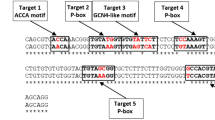Abstract
Reticuline is a key compound in the biosynthetic pathway for isoquinoline alkaloids in plants, which include morphine, codeine and berberine. We established cultured California poppy (Eschscholzia californica) cells, in which berberine bridge enzyme (BBE) was knocked down by RNA interference, to accumulate the important key intermediate reticuline. Both BBE mRNA accumulation and enzyme activity were effectively suppressed in transgenic cells. In these transgenic cells, end-products of isoquinoline alkaloid biosynthesis, such as sanguinarine, were considerably reduced and reticuline was accumulated at a maximum level of 310 μg/g-fresh weight. In addition, 1 g-fresh weight of these cells secreted significant amounts of reticuline into the medium, with a maximum level of 6 mg/20 mL culture medium. These cells also produced a methylated derivative of reticuline, laudanine, which could scarcely be detected in control cells. We discuss the potential application of RNAi technology in metabolic modification and the flexibility of plant secondary metabolism.






Similar content being viewed by others
Abbreviations
- BBE:
-
Berberine bridge enzyme
- RNAi:
-
RNA interference
- dsRNA:
-
Double-stranded RNA
- siRNA:
-
Small interfering RNA
References
Allen RS, Millgate AG, Chitty JA et al (2004) RNAi-mediated replacement of morphine with the nonnarcotic alkaloid reticuline in opium poppy. Nat Biotechnol 22:1559–1566
Bradford MM (1976) A rapid and sensitive method for the quantitation of microgram quantities of protein utilizing the principle of protein-dye binding. Anal Biochem 72:248–254
Choi KB, Morishige T, Shitan N et al (2002) Molecular cloning and characterization of coclaurine N-methyltransferase from cultured cells of Coptis japonica. J Biol Chem 277:830–835
Croteau R, Kutchan TM, Lewis NG (2000). Natural products (secondary metabolites). In: Buchanan B, Gruissem W, Jones R (eds) Biochemistry and molecular biology of plants. American Society of Plant Physiologists, Rockville, Maryland, pp 1250–1318
Facchini PJ (2001) Alkaloid biosynthesis in plants: biochemistry, cell biology, molecular regulation, and metabolic engineering applications. Ann Rev Plant Phys Plant Mol Biol 52:29–66
Frick S, Chitty JA, Kramell R, et al (2004) Transformation of opium poppy (Papaver somniferum L.) with antisense berberine bridge enzyme gene (anti-bbe) via somatic embryogenesis results in an altered ratio of alkaloids in latex but not in roots. Transgenic Res 13(6):607–613
Hashimoto T, Yamada Y (2003) New genes in alkaloid metabolism and transport. Curr Opin Biotechnol 14:163–168
Hauschild K, Pauli HH, Kutchan TM (1998) Isolation and analysis of a gene bbe1 encoding the berberine bridge enzyme from the California poppy Eschscholzia californica. Plant Mol Biol 36:473–478
Ikezawa N, Tanaka M, Nagayoshi M et al (2003) Molecular cloning and characterization of CYP719, a methylenedioxy bridge-forming enzyme that belongs to a novel P450 family, from cultured Coptis japonica cells. J Biol Chem 278:38557–38565
Jen GC, Chilton MD (1986) Activity of T-DNA borders in plant cell transformation by mini-T plasmids. J Bacteriol 166:491–499
Morishige T, Dubouzet E, Choi KB et al (2002) Molecular cloning of columbamine O-methyltransferase from cultured Coptis japonica cells. Eur J Biochem 269:5659–5667
Murray MG, Thompson WF (1980) Rapid isolation of high molecular weight plant DNA. Nucleic Acids Res 8:4321–4325
Nishiyama Y, Moriyasu M, Ichimaru M et al (2004) Quaternary isoquinoline alkaloids from Xylopia parviflora. Phytochem 65:939–944
Ounaroon A, Decker G, Schmidt J et al. (2003) (R,S)-Reticuline 7-O-methyltransferase and (R,S)-norcoclaurine 6-O-methyltransferase of Papaver somniferum - cDNA cloning and characterization of methyl transfer enzymes of alkaloid biosynthesis in opium poppy. Plant J 36:808–819
Park SU, Yu M, Facchini PJ (2002) Antisense RNA-mediated suppression of benzophenanthridine alkaloid biosynthesis in transgenic cell cultures of California poppy. Plant Physiol 128:696–706
Park SU, Yu M, Facchini PJ (2003) Modulation of berberine bridge enzyme levels in transgenic root cultures of California poppy alters the accumulation of benzophenanthridine alkaloids. Plant Mol Biol 51:153–164
Pauli HH, Kutchan TM (1998) Molecular cloning and functional heterologous expression of two alleles encoding (S)-N-methylcoclaurine 3′-hydroxylase (CYP80B1), a new methyl jasmonate-inducible cytochrome P-450-dependent mono-oxygenase of benzylisoquinoline alkaloid biosynthesis. Plant J 13:793–801
Sato F, Hashimoto T, Hachiya A et al (2001) Metabolic engineering of plant alkaloid biosynthesis. Proc Natl Acad Sci USA 98:367–372
Sato F, Yamada Y (2006) Engineering medicinal compounds in cell cultures. In: Bohnert HJ, Nguyen HT (eds) Bioengineering and Molecular Biology of Plant Pathways, vol. 1 In: Lewis NG (ed), Advances in Plant Biochemistry and Molecular Biology, Elsevier, (in press)
Shitan N, Bazin I, Dan K et al (2003) Involvement of CjMDR1, a plant multidrug-resistance-type ATP-binding cassette protein, in alkaloid transport in Coptis japonica. Proc Natl Acad Sci USA 100:751–756
Weid M, Ziegler J, Kutchan TM (2004) The roles of latex and the vascular bundle in morphine biosynthesis in the opium poppy, Papaver somniferum. Proc Natl Acad Sci USA 101:13957–13962
Wesley SV, Helliwell CA, Smith NA et al (2001) Construct design for efficient, effective and high-throughput gene silencing in plants. Plant J 27:581–590
Acknowledgements
We appreciate Dr. P Waterhouse for his kind gifts of pKANNIBAL and pART27 and Mr. T Takemura for his excellent technical assistance in maintaining stock cultures. We thank Dr. W Cui of Kobe Pharmaceutical University and Mitsui Chemicals Inc for their generous gifts of the alkaloids. This research was supported in part by Grants from the Research for the Future Program (JSPS-RFTF00L01606) of the Japan Society for the Promotion of Science (to FS) and the New Energy and Industrial Technology Development Organization for projects in the “Development of Transgenic Plants for Production of Industrial Materials” (to FS).
Author information
Authors and Affiliations
Corresponding author
Rights and permissions
About this article
Cite this article
Fujii, N., Inui, T., Iwasa, K. et al. Knockdown of berberine bridge enzyme by RNAi accumulates (S)-reticuline and activates a silent pathway in cultured California poppy cells. Transgenic Res 16, 363–375 (2007). https://doi.org/10.1007/s11248-006-9040-4
Received:
Accepted:
Published:
Issue Date:
DOI: https://doi.org/10.1007/s11248-006-9040-4




